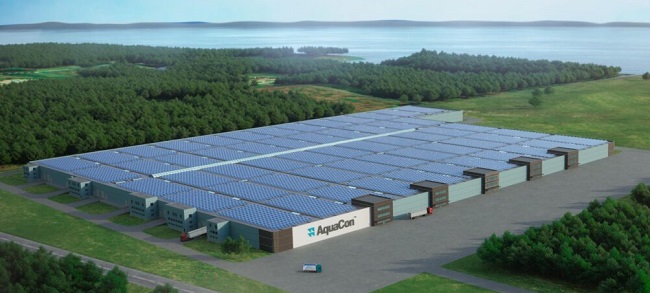
News
Regulations
Sustainability
Scientists, residents raise concern over RAS plans in Maryland
August 24, 2022 By Nestor Arellano
 A digital rendering of AquaCon's planned RAS facilities in Maryland. (Photo: AquaCon)
A digital rendering of AquaCon's planned RAS facilities in Maryland. (Photo: AquaCon) A project to build a recirculating aquaculture system (RAS) facility to grow salmon in a tidal estuary in Maryland, could harm the local population of sturgeon which are considered an endangered species. This was the concern raised by scientists, environmentalist and residents who attended a recent hearing held by the Maryland Department of Environment (MED).
The hearing on August 10, was one of the first official meeting where members of the public were able to speak about the plans of Norwegian aquaculture company AquaCon to build a 25-acre RAS facility near Marshyhope Creek, on the Eastern Shore of Maryland. The MED still has to decide on whether to permit AquaCon to go through its plans to build the facility which is expected to produce more than 15,000 tons of salmon each year.
People opposed to the project are worried that discharge water from the facility could alter the water and salinity of the creek and cause nutrient pollution.
“This is unique habitat for sturgeon in Maryland waters,” Dr. Dave Secor, a University of Maryland Center for Environmental Science professor, was quoted as saying in the Chesapeake Bay Foundation CFB) website. “Atlantic sturgeon come here year after year after year. AquaCon is an existential threat to the smallest of Atlantic sturgeon populations, and that’s a very bold statement.”
The professor was among the people who attended the hearing to explain the risks of the facility to the local sturgeon population.
“This permit is missing significant technical information,” said Alan Girard, director of the CFB for Eastern Shore.
Girard said he was referring to questions raised in Maryland Department of Natural Resources comment on the AquaCon project. The department work with MED when it comes to writing permits. Among the departments questions were:
- Does the purge water need to be maintained at a temperature other than the ambient temperature of the incoming water from the Marshyhope Creek?
- Will salinity of the discharge water from the facility be treated to match the salinity of of the water in Marshyhope Creek? Will there be any changes to the pH of the creek water?
- Have limits for nutrients and suspended solids for the discharge been determined?
The states DNR also said that to minimize impacts to spawning fish species, withdrawal of water from the Marshyhope Creek should only be allowed of the intake pipe is covered with a filter having a nominal mesh size of one millimeter and that the intake velocity does not exceed0.50 feet/second to minimize the potential to entrain fish eggs and or larvae.
Print this page